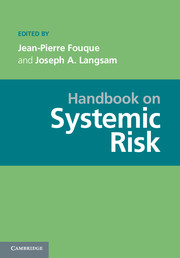Book contents
- Frontmatter
- Contents
- Contributors
- Introduction
- PART I DATA: THE PREREQUISITE FOR MANAGING SYSTEMIC RISK
- PART II STATISTICS AND SYSTEMIC RISK
- PART III MEASURING AND REGULATING SYSTEMIC RISK
- PART IV NETWORKS
- PART V SYSTEMIC RISK ANDMATHEMATICAL FINANCE
- PART VI COUNTERPARTY RISK AND SYSTEMIC RISK
- PART VII ALGORITHMIC TRADING
- PART VIII BEHAVIORAL FINANCE: THE PSYCHOLOGICAL DIMENSION OF SYSTEMIC RISK
- PART IX REGULATION
- PART X COMPUTATIONAL ISSUES AND REQUIREMENTS
- PART XI ACCOUNTING ISSUES
PART IX - REGULATION
Published online by Cambridge University Press: 05 June 2013
- Frontmatter
- Contents
- Contributors
- Introduction
- PART I DATA: THE PREREQUISITE FOR MANAGING SYSTEMIC RISK
- PART II STATISTICS AND SYSTEMIC RISK
- PART III MEASURING AND REGULATING SYSTEMIC RISK
- PART IV NETWORKS
- PART V SYSTEMIC RISK ANDMATHEMATICAL FINANCE
- PART VI COUNTERPARTY RISK AND SYSTEMIC RISK
- PART VII ALGORITHMIC TRADING
- PART VIII BEHAVIORAL FINANCE: THE PSYCHOLOGICAL DIMENSION OF SYSTEMIC RISK
- PART IX REGULATION
- PART X COMPUTATIONAL ISSUES AND REQUIREMENTS
- PART XI ACCOUNTING ISSUES
Summary
Regulation: Introduction
Policymakers have long been concerned with the sources and effects of systemic risk. Unfortunately, however, relatively few resources have been put to identifying and measuring this risk. There should be no doubt that the response to the financial crisis of 2007-09 requires good measures of systemic risk. And, indeed, the Dodd–Frank Act and international efforts sponsored by the Basel Committee and the Financial Stability Board mandate more stringent supervision of financial institutions that pose appreciable systemic risk.
These efforts provide a general sense of factors seen to contribute to systemic risk, including size, interconnectedness, and substitutability. The three chapters in this part of the Handbook generally take matters several steps further. The first, authored by Carsten Detken and Per Nymand-Andersen, focuses on the European approach to systemic risk, including a description of changes to the supervisory architecture for financial institutions devised in the wake of the financial crisis. It discusses the data and analytics necessary to identify systemic risk and describes the vulnerabilities that may precipitate a systemic crisis. The chapter suggests a framework for assessing both the potential impact of the risks identified as well as the resilience of the financial sector. Finally, the chapter suggests a policy response process and also briefly discusses the supervisory response to systemic risk underway in the United States.
- Type
- Chapter
- Information
- Handbook on Systemic Risk , pp. 743 - 747Publisher: Cambridge University PressPrint publication year: 2013



